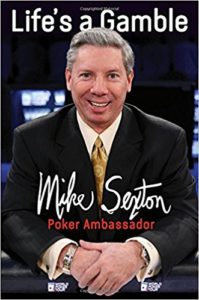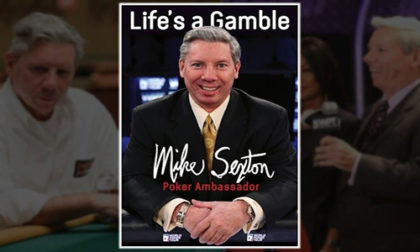Flushdraw Review: Mike Sexton’s “Life’s a Gamble”
We return today to Flushdraw’s occasionally appearing book reviews with a look at Life’s a Gamble, the new book by the Anbassador of Poker, Mike Sexton. Best known for his dual roles as color commentator for the World Poker Tour and frontman for PartyPoker, Sexton offers here a semi-autobiographical look at his own gambling background, centering on the poker world of the ’80s and ’90s that Sexton became a part of upon his relocation from the Midwest to Las Vegas.
 Sexton was always a gambler, as he tells you from the book’s very first page, when he hooked up with a neighborhood friend and, in some ways, his gambling mentor, Danny Robison, in the very middle-class confines of Toledo, Ohio. Sexton would later follow in the footsteps of Robison and another Toledo-area poker product, David “Chip” Reese, and how Sexton went from being the second son of dance-studio instructors, through a college-scholarship gymnast, and on to a lifetime of gambling takes up much of the early portion of Life’s a Gamble.
Sexton was always a gambler, as he tells you from the book’s very first page, when he hooked up with a neighborhood friend and, in some ways, his gambling mentor, Danny Robison, in the very middle-class confines of Toledo, Ohio. Sexton would later follow in the footsteps of Robison and another Toledo-area poker product, David “Chip” Reese, and how Sexton went from being the second son of dance-studio instructors, through a college-scholarship gymnast, and on to a lifetime of gambling takes up much of the early portion of Life’s a Gamble.
Yet while there are chunks of self-history here, this really isn’t an autobiography. Instead, Life’s a Gamble changes gears midway through and becomes a collection of gambling largely old-time Vegas gambling stories. It’s all a good read, told in Sexton’s ambling, down-home style, though without the reader keeping half an eye on the table of contents, one wouldn’t be sure just what collection of tales is coming next.
Most of what people think about when the name “Mike Sexton” is mentioned is covered here, however. That includes the two big career moves mentioned at the top, Sexton’s twin affiliations with PartyPoker and the World Poker Tour. There’s plenty of behind-the-scenes info on both ventures here, if offered from a Sexton-centric perspective, and that’s about as close as it gets. I learned plenty knew from reading this book, such as that Sexton sold his own holdings in PartyGaming some 18 months before that company’s famed IPO last decade. I always thought Sexton still had a little piece, though that does explain why Sexton never faced the legal troubles other PartyGaming owners eventually encountered.
Sexton also offers his take on why the WPT and the Travel Channel parted ways after five very successful seasons, and I won’t divulge why – you can buy the book to find out, if you wish – except he says it was the WPT’s misstep.
Most of the latter stages of Life’s a Gamble, however, are given over to older times and a wide assortment of gambling stories, beginning with poker and moving on to golf, where Sexton and his Vegas friends have wagered for stakes even high than at the poker tables. If you’re into only poker, the chapters on golf-related gambling might leave you cold, but they’re a part of Sexton’s tale, as is perhaps his biggest life leak, sports betting.
Sexton also spends what seems like nearly half the book on his various tales of other legendary Vegas gamblers. There’s a largish chapter devoted to WSOP Main Events of the pre-televised area, plus a handful of chapters at the back dedicated to individual gamblers, such as Doyle Brunson, Puggy Pearson, Stuey Ungar, Chip Reese, Archie Karas, and plenty of others.
There’s plenty of storytelling here, as you might expect, since that’s Sexton’s forte. It’s not quite clear sometimes where Sexton’s own stories end and others’ stories (retold by him) begin, and the book is loosely structured – it starts off as something approaching a straighforward autobiography and winds up as a mélange of the Vegas gambling scene.
Sexton also doesn’t peek too far under the covers into troublesome areas. The evils of drug use figure into the book in places, particularly when dealing with the Stuey Ungar stories. Ungar and Sexton were close friends, and it was Sexton who paid for Ungar’s hotel room during Ungar’s last months in a noble but failed attempt to help Ungar get clean.
Sexton’s close friendship with several of the book’s nearly larger-than-life characters also results in him pulling his punches here and there. Mentions of a few of online poker’s historic villains (Russ Hamilton at the top of the list) are dealt with very lightly. Sexton has an old-school fondness for Puggy Pearson, though others are less enamored by tales of the Poker Hall of Famer.
And then there’s Archie Karas, who went on the “The Run,” the legendary $40 million winning streak shooting craps in Vegas casinos. Karas and the Sextons (including Mike and his late brother, Tom) became good friends along the way, though Karas went busto, giving back all of that $40 million within a couple of years, and has scuffled along ever since. Karas turned out to be quite the angleshooter and cheater himself, being tossed out of several casinos in California and Nevada over the last decade or so for various offenses.
Sexton dismisses Karas in one the book’s final (and very brief) chapters, noting both “The Run” and Karas’s eventual addition to Nevada’s notorious Black Book of banned gamblers. Yet not mentioned here is how Sexton and his brother obtained a car for Karas to drive during Karas’s later down days. That was very typical Sexton stuff, and also a part of how Las Vegas’s core brotherhood of veteran gamblers helped each other through “between bankrolls” stretches. It’s also been widely conjectured that it was Mike Sexton who funded Karas’s attempted poker comeback at the WSOP late last decade. Marked cards kept showing up at Karas’s tables, though Karas denied involvement… and that included to me, personally, at the 2008 WSOP.
Sexton’s light touch on gambling matters gone really bad also affects his self-reporting. Sexton allows that he’s been through plenty of bad stretches. Most of them seem, according to him, to be about sports-betting runs gone really bad.
How bad? In the late ’90s, there were rumors that Sexton himself had markers out all over Vegas. It was about this time that Sexton recounts a failed business venture that he joined not too long before PartyPoker debuted. One can read this stretch of Life’s a Gamble and get the read that Sexton’s pockets were empty when the Party frontman and poker-developer deal came along. But Sexton doesn’t quite say it; instead there’s a tale about how he played hardball with Party’s founder, Ruth Parasol, until he got most of what he wanted.
It’s a good, engaging tale anyway. Maybe a little loose in the telling, but then again, that’s always been the Sexton style.
There are a fee other problems with the book, none of which truly amount to page-stoppers. One of the most typical in books of this nature is that the newer games and newer players tend to get short shrift; then again, that’s not really Mike’s world. Perhaps the worst gaffe in this book’s pages involves one of the private California home games that Sexton often attended, where the billionaire host also invited a young hotshot, whom Sexton identifies as “Tom Durr”. We can safely assume this is Tom Dwan, known online as durrrr. That neither Sexton or his editors and publishers thought to check into this is a bad whoops, and it’s emblematic of why this book is only good or very good, and not quite great. The Sextons – and this was true of his late brother, Tom, as well — have always had the storyteller’s gift of gab. Attention to detail, maybe not quite so much.
Is Life’s a Gamble a great book? Nah. But it’s a pretty good one, and it’s far, far better than the last “collection of stories by a famed poker player” book I read, Joe Hachem’s dismal Pass the Sugar.
On Amazon, Life’s a Gamble has gotten plenty of 5-star ratings, a handful of 4-stars, and a smattering of lower marks. The 4-star ratings are the most accurate ones. If one could fine-tune it further, it’s be a 3.8 or something like that. It’s well worth the read, and it offers something for everyone, but it’s not quite the tour de force it might have been. It’s an engaging, enjoyable read, and in the final analysis, that’s enough.
Life’s a Gamble
Mike Sexton
D&B Publishing, $24.95 (hardcover, MSRP)




















COMMENTS